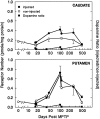Dynamic changes in striatal dopamine D2 and D3 receptor protein and mRNA in response to 1-methyl-4-phenyl-1,2,3,6-tetrahydropyridine (MPTP) denervation in baboons
- PMID: 8922433
- PMCID: PMC6579075
- DOI: 10.1523/JNEUROSCI.16-23-07776.1996
Dynamic changes in striatal dopamine D2 and D3 receptor protein and mRNA in response to 1-methyl-4-phenyl-1,2,3,6-tetrahydropyridine (MPTP) denervation in baboons
Abstract
Loss of nigrostriatal neurons leads to striatal dopamine deficiency and subsequent development of parkinsonism. The effects of this denervation on D2-like receptors in striatum remain unclear. Most studies have demonstrated increases in striatal dopamine D2-like receptors in response to 1-methyl-4-phenyl-1,2,3,6-tetrahydropyridine (MPTP)-mediated denervation, but others have found either decreases or no change in binding. To clarify the response to denervation, we have investigated the time-dependent changes in dopamine D2, D3, and D4 receptor protein and mRNA levels in unilaterally MPTP-lesioned baboons. MPTP (0.4 mg/kg) was infused into one internal carotid artery, producing a contralateral hemi-parkinsonian syndrome. After MPTP treatment, the animals were maintained for 17-480 d and then euthanized. MPTP decreased ipsilateral dopamine content by >90%, which did not change with time. Ipsilateral D2-like receptor binding in caudate and putamen initially decreased then increased two- to sevenfold over the first 100 d and returned to near baseline levels by 480 d. Relative levels of D2 mRNA were essentially unchanged over this period. D4 mRNA was not detected. In contrast, D3 mRNA increased sixfold by 2 weeks and then decreased. At the peak period of increase in binding sites, all D2-like receptors were in a micromolar affinity agonist-binding state, implying an increase in uncoupled D2 but not D3 receptor protein. Taken together, these data suggest that MPTP-induced changes in D2-like dopamine receptors are complex and include translational or post-translational mechanisms.
Figures





References
-
- Alexander GM, Brainard DL, Gordon SW, Hichens M, Grothusen JR, Schwartzman RJ. Dopamine receptor changes in untreated and (+)-PHNO-treated MPTP parkinsonian primates. Brain Res. 1991;547:181–189. - PubMed
-
- Ariano MA, Sibley DR. Dopamine receptor distribution in the rat CNS: elucidation using anti-peptide antisera directed against DIA and D3 subtypes. Brain Res. 1994;649:95–110. - PubMed
-
- Ballard PA, Tetrud JW, Langston JW. Permanent human parkinsonism due to 1-methyl-4-phenyl-1,2,3,6-tetrahydropyridine (MPTP): seven cases. Neurology. 1985;35:949–956. - PubMed
-
- Bankiewicz K, Oldfield E, Chiueh C, Doppman J, Jacobowitz D, Kopin I. Hemiparkinsonism in monkeys after unilateral internal carotid artery infusion of 1-methyl-4-phenyl-1,2,3,6-tetrahydropyridine (MPTP). Life Sci. 1986;39:7–16. - PubMed
-
- Bergman H, Wichmann T, DeLong MR. Reversal of experimental parkinsonism by lesions of subthalamic nucleus. Science. 1990;249:1436–1438. - PubMed
Publication types
MeSH terms
Substances
Associated data
- Actions
Grants and funding
LinkOut - more resources
Full Text Sources
